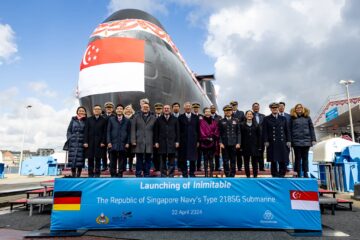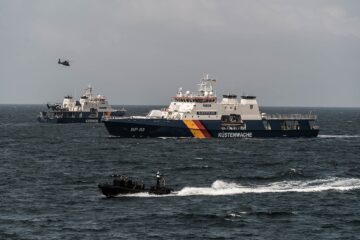Attending the formal MRCV steel-cutting ceremony, conducted by a robot in ST Engineering’s shipyard, was Rear Admiral Sean Wat, Chief of Navy. He was accompanied by members of the Defence Science and Technology Agency (DSTA), the government organisation in charge of the shipbuilding project.
On the occasion, the Republic of Singapore Navy (RSN) confirmed that the first MRCV is on track to join the fleet in 2028. It stated:
“The new MRCVs will function as ‘motherships’, capable of controlling unmanned assets across the air, surface and underwater domains.”
Singapore’s Ministry of Defence (MINDEF) announced on 27 March 2023 that ST Engineering had been awarded the contract for detailed design and construction of the six frigate-sized MRCVs. The DSTA also contracted Saab, who partnered with Odense Maritime Technology (OMT) in Denmark, to jointly develop the MRCV’s basic design. The deadline imposed for this basic-design phase was the end of 2023. Such a tripartite arrangement is not unique for Singapore, for the DSTA, Saab and ST Engineering worked together on the RSN’s Independence-class Littoral Mission Vessels in similar fashion, these having been commissioned from 2017-20.
ST Engineering is responsible for “procurement and integration of the platform equipment and MINDEF-furnished equipment. Its scope of work will also include the undertaking of design and the provision of integrated logistics support engineering to support and maintain operational readiness during the lifespan of the MRCVs.”

The shipbuilder added, “The MRCV is designed to function as a mothership and can operate a range of manned and unmanned systems in a flexible, intuitive and integrated manner. The MRCV will be able to support a wide spectrum of missions with maximum combat effectiveness.” Indeed, the MRCV may turn out to be a poster child for manned-unmanned teaming, as Singapore leverages considerable expertise and experience in unmanned technologies.
The MRCV’s multirole concept is important to the RSN, since Singapore’s conscription-dependent military is facing a declining pool of manpower. Flexible, multirole platforms will allow the navy to tackle varied contingencies in years to come, even as new threats such as unmanned aerial vehicles and loitering munitions emerge. This approach enables the navy to expand its operational envelope without needing more personnel.
Richard Hedström, Head of Product Management Business Unit Surface Ships at Saab, told Naval News: “The future navy of any nation needs to handle all forms of threats on the spectrum, from full-scale war to peacetime operations such as surveillance of seabed infrastructure. Most likely, unmanned systems will support any type of naval operation. Many nations have identified this, and our Singaporean customer is one of them. The RSN’s Multirole Combat Vessel is designed to act as a mothership for unmanned systems, besides more conventional capabilities such as surface warfare.”

Furthermore, the ships will possess automated systems as much as possible. The class will utilise artificial intelligence and data analytics to create a highly digital ship. ST Engineering said the vessels will “harness the ‘multiplier effect’ of digital technologies to meet the RSN’s requirements for faster, more efficient operations”.
About MRCV
The MRCV design – resembling ST Engineering’s own Vanguard 130 concept that is 130m long and displaces 5,000 tonnes – features an integrated mast, stern flight deck, helicopter hangar and twin stern ramps for deploying small craft. A strong candidate for the integrated mast must be the Saab Lightweight Integrated Mast (SLIM), since it is already employed on Singapore’s eight Independence-class vessels.
The MRCV will replace six 595-tonne Victory-class missile corvettes within the RSN, but Singapore’s MINDEF remains tight-lipped about exact specifications and equipment. However, it is obvious that the MRCVs will be far more capable and larger than the six-corvette Victory class that dates from the early 1990s.
Naval News learned from various industry sources during IMDEX Asia 2023 that the MRCV would have a displacement of around 8,000 tons and a crew complement of about 80 sailors, indicating a high level of automation in the platform. Naval News understand that the mothership vessels would feature:
- Leonardo’s 76mm naval gun in the STRALES variant;
- MBDA’s VL MICA NG and Aster B1 NT air defence missiles;
- ST Engineering / IAI Blue Spear anti-ship missiles;
- Thales’ SeaFire multifunction radar (in four fixed array configuration as aboard the FDI frigate);
- Safran’s PASEO XLR EO/IR system;
- Safran’s NGDS decoy launching system.

The MRCV is set to become the first surface combatant fitted with a combination of ASTER and VL MICA missiles. The RSN is an existing user of both missiles: ASTER are fitted aboard the Formidable-class frigates while VL-MICA are fitted aboard the Littoral Mission Vessels.

The vessels are set to host, launch and recover ST Engineering’s VENUS family of unmanned surface vessels (USV), both in their mine warfare and maritime security variants. The MRCV will also accommodate a number of unmanned aerial vehicles (UAV).
During the naval defense event held in Singapore last year we also learned that competitions were still ongoing for the secondary gun systems (between Leonardo’s Hitrole and Rafael’s Typhoon), the sonar suite (between DSIT and Thales) and the torpedoes (between MU90 and A244 MOD.3 LWT), among other equipment.
Check out our video coverage of IMDEX Asia 2023 focusing on MRCV:
Story by Gordon Arthur with additional reporting by Xavier Vavasseur






